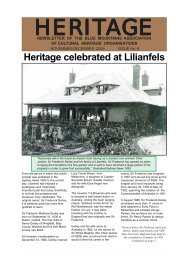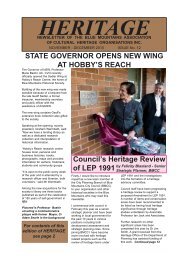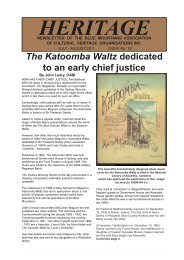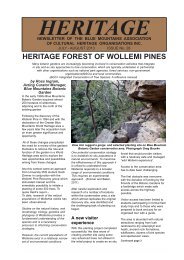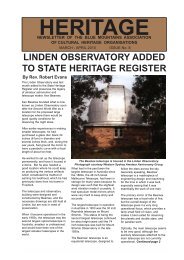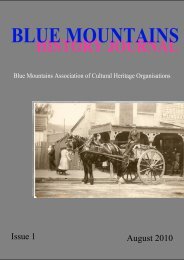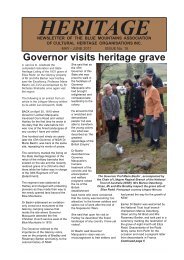Blue Mountains History Journal Issue 2
Blue Mountains History Journal Issue 2
Blue Mountains History Journal Issue 2
Create successful ePaper yourself
Turn your PDF publications into a flip-book with our unique Google optimized e-Paper software.
<strong>Blue</strong> <strong>Mountains</strong> <strong>History</strong> <strong>Journal</strong> 2; 2011<br />
congregation were expected to know where to go - but pity the visitor! From the end of March 1913<br />
(Anonymous 1913c) again there was an advertising hiatus (for twenty months) until it was announced<br />
that for Sunday 29 November 1914:<br />
“Medlow Bath. Holy Mass, 8 a.m., in the local hall.” (Anonymous 1914a; also see Anonymous<br />
1914c).<br />
and another entry in that same newspaper issue signified that the unnamed building was most probably<br />
“Flannigan’s Hall” (Anonymous 1914b) which is more correctly spelled “Flanagan’s hall” (Anonymous<br />
1913a). That is now a castellated building at 1 Railway Parade - to the north of the Railway platform<br />
(Kaldy 1983, p.65). Originally that was the site of a store run by Isabella Smith in 1904 and 1905; it<br />
was purchased by Mark Foy in 1905 to extend and create a hall but when that work was completed has<br />
not been established (Heritage Office of NSW 2002, SHI 1170284). However the first store building<br />
would not have been suitable for holding a mass so the earliest observances were probably held in a<br />
part of what became the Hydro Majestic Hotel. Masses from 1906 until 1914 may well have been held<br />
in the Hall but proof is lacking at present. The building was again extended by Mark Foy in 1910 to<br />
become the Post & Telegraph Office (Figure 18A - lettering indistinct) for a few years; note that the<br />
style is the same as he used for a northern wing of his Hydro Majestic Hotel. In 1916 the Post &<br />
Telegraph Office became known as Rice’s Hall but subsequently has been rebadged several times e.g.<br />
Figure 18B.<br />
A (photo – N. & E. Kirkland 1990s)<br />
(BMHS photo 3872)<br />
B (photo – Peter Rickwood 2011)<br />
Figure 18. The former Post & Telegraph Office building at one time used by the Catholic Church.<br />
A dance was held in March 1913 resulting in<br />
“... a fair cheque going to the Catholic church ...”<br />
for an unspecified purpose (Anonymous 1913d). Much of this activity took place whilst J. Considine<br />
was Administrator 1912-1915 (Baker 1990, p.149) and it continued for a short time whilst Father St.<br />
Clair Joseph Bridge was in charge of the Parish. Not having a permanent meeting place was not a<br />
situation that the worshippers of Medlow Bath liked for early in January 1916 the Catholic congregation<br />
decided<br />
“to make vigorous efforts to secure a church”<br />
and so again started to raise money. First they organised a fund raising evening on 1 February<br />
(Anonymous 1916a,c), then a bazaar in Easter Week<br />
“... for the Medlow R.C. Church building fund.” (Anonymous 1916b)<br />
and next a Euchre Party and Dance late in April 1916 (Anonymous 1916d). In 1917 there was held in<br />
Medlow Bath a:<br />
“.. social in aid of the R.C. Church building fund ...” (Anonymous 1917)<br />
However, no further notices in relation to the building fund have been located and that building did not<br />
eventuate. Nevertheless, after an interval of 18 years the ‘Church’ re-acquired the name of St. Patrick’s<br />
(Anonymous 1922a,b) but that appellation was not used in the same publication in the following year<br />
(Anonymous 1923a) and thereafter. Unfortunately the known copies of these publications are few and<br />
all have been scrutinised so this is the limit of our knowledge concerning that name.<br />
30 Back to Contents




